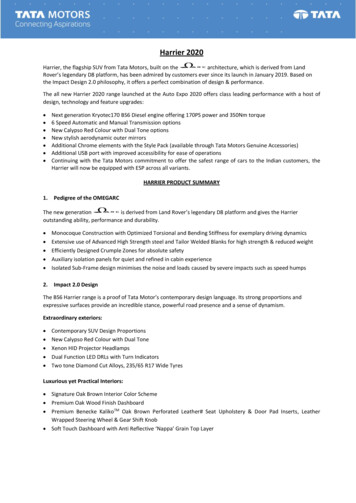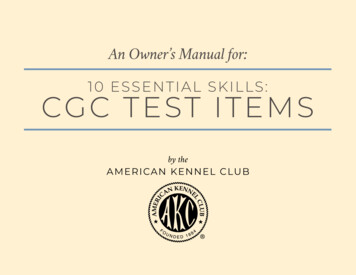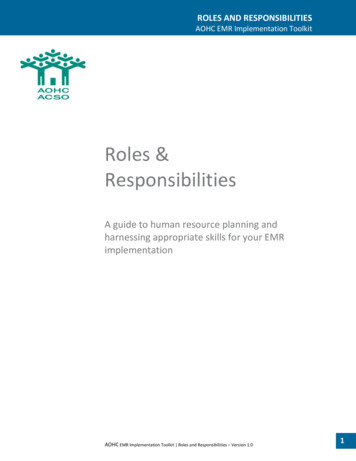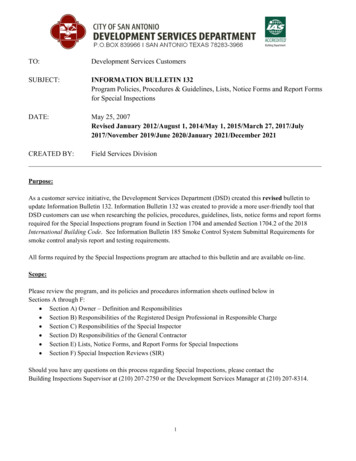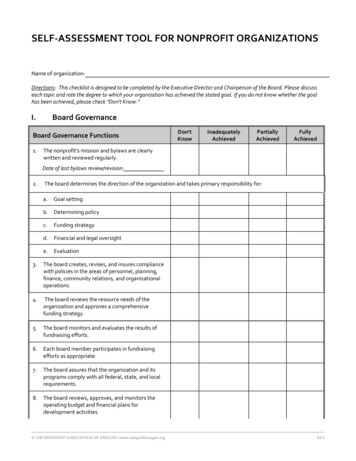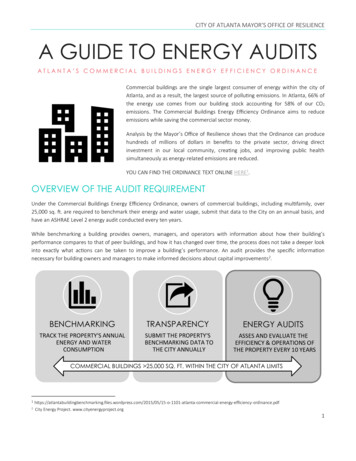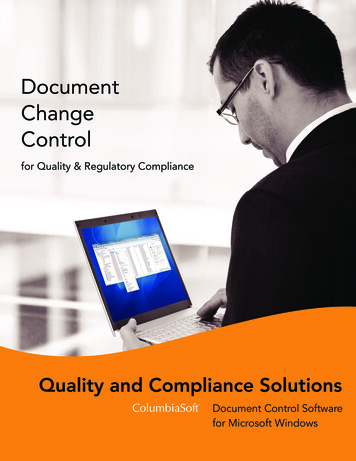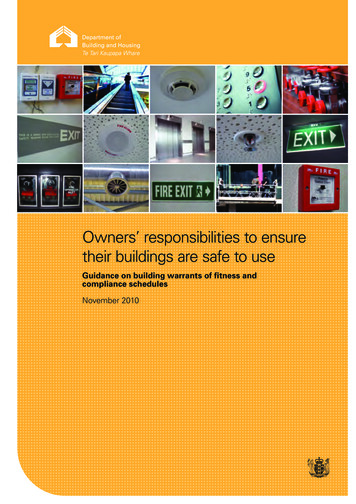
Transcription
Owners’ responsibilities to ensuretheir buildings are safe to useGuidance on building warrants of fitness andcompliance schedulesNovember 2010
Contents1Purpose and introduction 12 The Building Act 2004 23 Explanation of terms 34 The responsibilities of building owners 55 Roadmap for three scenarios involving existing compliance schedules 66 How a Compliance schedule is developed 76.1: Applying for a building consent 76.2: Building consent issued 86.3: Building work completed and compliance schedule issued with the code compliance certificate 97Building warrant of fitness process 117.1: Inspections and maintenance of specified systems 117.2: Building warrant of fitness issued 128 Amendment to a compliance schedule 138.1: Amendment triggered by council decision, owner’s request or IQP recommendation 138.2: Amendment triggered by a building consent 149 Useful information when buying a building with a compliance schedule 1510 Fines for offences 1611 Further guidance and information 17Appendices 18Appendix 1:Appendix 2:Appendix 3:Appendix 4:List of specified systems 18Application for amendment of compliance schedule 19Building warrant of fitness 21Certificates of compliance with inspection, maintenance and reporting procedures 22
1 Purpose and introductionThe purpose of this document is to provide guidance to building owners (and their agents) on howto meet the requirements of the Building Act 2004 (the Building Act) relating to building warrantsof fitness, compliance schedules and related matters.This guidance is particularly relevant to the owners of any building that is not a stand-alone house(unless the house has a cable car) because the building owner is responsible for ensuring anyspecified systems (which have mostly life safety systems) continue to ensure the buildingis safe for people to enter, occupy or work in.This guidance primarily covers: how a compliance schedule is developedthe building warrant of fitness processamending a compliance scheduleuseful information when buying a building with a compliance schedule.For a quick overview of the compliance schedule and building warrant of fitness system, pleaserefer to the roadmap flowcharts on page 6. This will identify the start point and the procedurefor the scenario that best suits the reader’s situation. There are three scenarios which deal withexisting compliance schedules. They are: a building with an existing compliance schedule an amendment to a compliance schedule triggered by a council decision, the owner’s requestor on the recommendation of an independent qualified person an amendment to a compliance schedule triggered by a building consent.For the purposes of clarity and logical sequencing, this document follows the early life of a newbuilding with specified systems from design, construction, occupation, through to on-sellingthe building. The commentary focuses primarily on matters associated with specified systems,compliance schedules and building warrants of fitness, and not on the building consent process.A story based on the life of a new commercial building provides a real-life example of thecompliance schedule/building warrant of fitness process and there are also a number ofsupporting notes throughout the document.For those building owners who are still uncertain about what is required under the Building Actafter reading this guidance, it is strongly recommended that they seek appropriate professionaladvice (for example, from an independent qualified person or the local council’s buildingcontrol department).Ow n e r s ’ r es p o n s i b i l i t i es to e n su r e t h e i r b u i l d i n g s a r e sa f e to u s e
2 The Building Act 2004The Building Act is the primary piece of legislation governing buildings in New Zealand. It sets therequirements for the construction, alteration, demolition, use and maintenance of new and existingbuildings. The Building Act’s purpose is to ensure buildings are safe and built right first time.It is administered centrally by the Department of Building and Housing (the Department) and isregulated locally by regional, city and district councils.Under the Building Act, the New Zealand Building Code (as part of the Building Regulations)defines the minimum standards buildings must meet for the whole of New Zealand.The Building Act also requires the owner of a building with specified systems (such as sprinklers,lifts, fire alarms) to have a compliance schedule and to provide the council with an annual buildingwarrant of fitness to confirm that the building’s specified systems are being maintained and areoperating effectively.You can get more information about the Building Act 2004 online at:www.dbh.govt.nz/blc-building-act Ow n e r s ’ r es p o n s i b i l i t i es to e n su r e t h e i r b u i l d i n g s a r e sa f e to u s e
3 Explanation of termsThe following explanations of terms used in this document are for the purposes of this documentonly. When using these terms please refer to the Building Act, Building Regulations and otherprimary sources for their full definitions.Building consent: An approval issued by a building consent authority (the building controldepartment of the district, city or regional council) to undertake building work in accordancewith the approved plans and specifications.Code compliance certificate: A certificate issued by a council, at the completion of buildingwork, confirming that the council is satisfied on reasonable grounds that the building workundertaken complies with the Building Code and approved building consent.Commercial building: A building or use of a building where any natural resources, goods,services or money are either developed, sold, exchanged or stored. For example, a bank,car-parking facility, computer centre, office, restaurant, shop, showroom or storage facility.Compliance schedule: A document issued by a council for buildings containing specifiedsystems. The compliance schedule states the specified systems, their performance standardsand includes the inspection, maintenance and reporting procedures needed to keep themin good working order.Compliance schedule statement: A written statement issued by a council as temporary publicnotification of the specified systems covered by the compliance schedule for a building andwhere the compliance schedule is kept. It is not a statement about the performance of thespecified systems listed. It is required to be publicly displayed for 12 months from the issueof the compliance schedule. It is then replaced by the first building warrant of fitness.Council: A district, city or regional council having the jurisdiction over the area where a buildingis located. Most councils are also building consent authorities that issue building consents,code compliance certificates and compliance schedules.Form 11 – Application for amending a compliance schedule:This form is used to formally advise the council of any change required to a compliance schedule.Refer to Appendix 2 for a worked example.Form 12 – Building warrant of fitness: A written statement issued annually to the council,a copy of which is also publicly displayed in the building. The building warrant of fitness isa declaration by the building owner, or the building owner’s agent, that all the specified systemsin the building have been inspected, maintained and reported in accordance with the complianceschedule for a period of 12 months prior to the issue date.The warrant of fitness for a building must be prepared in accordance with the prescribed form(Form 12) in the Building (Forms) Regulations 2004. Refer to Appendix 3 for a worked example.Form 12A – Certificate of compliance with inspection, maintenance and reportingprocedures: This form is used as verification that the inspection and maintenance proceduresunder the compliance schedule have been carried out. They are issued by each independentqualified person who undertook inspection or maintenance of the building’s specified systems.Refer to Appendix 4 for worked examples.Ow n e r s ’ r es p o n s i b i l i t i es to e n su r e t h e i r b u i l d i n g s a r e sa f e to u s e
Independent qualified person (IQP): A person (or firm) approved by a council as qualifiedto inspect, maintain and report on specified systems.Inspection and maintenance reports: Annual written reports which are kept with thecompliance schedule for at least two years. This includes log books and test certificates.Performance standard: The level of performance a specified system was intended to meet,and to continue to meet, at the time it was designed and installed in a building.Resource consent: A document issued by council giving town planning approval for certainactivities and buildings on a property (covered by the Resource Management Act 1991).Specified systems: Specified systems are systems or features that contribute to the properfunctioning of a building. Specified systems require ongoing inspection and maintenance to ensurethey function as required, because if they fail to operate properly, they have the potential toadversely affect health or life safety.The specified systems are listed in Schedule 1 of the Building (Specified Systems, Change the Use,and Earthquake-prone Buildings) Regulations 2005, and in Appendix 1 of this document.Examples include, but are not limited to, sprinkler systems, fire alarms, lifts, escalators andcable cars.Third-party verification: A process a council can use for getting an independent party toconfirm that a specified system has been installed and is functioning to the required standardso they can be satisfied on reasonable grounds that the work complies with the Building Codeand the performance standard specified in the design. Verification might include installationcertificates, commissioning results and test reports. Ow n e r s ’ r es p o n s i b i l i t i es to e n su r e t h e i r b u i l d i n g s a r e sa f e to u s e
4 The responsibilities of building ownersIf you own a building that contains specified systems the Building Act requires you to havea compliance schedule and you must ensure the effective operation of all the specifiedsystems for the life of the building. This requirement does not apply to single household units(residential homes) unless they have a cable car. This is achieved by continuously meetingtheir respective performance standards and all the inspection, maintenance and reportingrequirements of the compliance schedule issued by the council.To help ensure your responsibilities have been met, the Building Act requires you to sign,issue and publicly display an annual building warrant of fitness and provide a copy annuallyto the council whose district the building is in.It is also your responsibility to keep the compliance schedule in the location nominated on thecompliance schedule statement and building warrant of fitness, so that it, and other documentsare readily available for inspection by authorised people (such as council inspectors, fire servicepersonnel and independent qualified persons). These include annual written reports, log books(records of inspections by owner/tenant/maintenance and inspection personnel) and testcertificates which are to be filed, for at least two years, with the compliance schedule.Ow n e r s ’ r es p o n s i b i l i t i es to e n su r e t h e i r b u i l d i n g s a r e sa f e to u s e
5 Roadmap for three scenarios involvingexisting compliance schedulesScenario AScenario BScenario CBuilding hasan existingcompliance scheduleAmendments tocompliance scheduletriggered byCouncil decision,owner’s requestor IQP recommendationAmendments tocompliance scheduletriggered bybuilding consent8.2Triggered bybuilding consentpage 146.1Applying fora building consentpage 76.2Building consent issuedpage 8 8.1Amendedcompliance schedule issuedpage 136.3Building work completed andamended compliance scheduleissued with codecompliance certificatepage 97.1Inspections and maintenanceof specified systemspage 117.1Inspections and maintenanceof specified systemspage 117.1Inspections and maintenanceof specified systemspage 117.2Buildingwarrant of fitness issuedpage 127.2Buildingwarrant of fitness issuedpage 127.2Buildingwarrant of fitness issuedpage 12Ow n e r s ’ r es p o n s i b i l i t i es to e n su r e t h e i r b u i l d i n g s a r e sa f e to u s e
6 How a compliance schedule istypically developed6.1 Applying for a building consentWhen you apply for a building consent for a new (or existing) building with specified systems,you will need to provide information with your application to enable the council to compile (or amend)the compliance schedule.The council will require details of the design features of the specified systems and proposedprocedures for inspection, maintenance and reporting so they can be included in the complianceschedule. This will also include the performance standard a specified system is intended to meet,and to continue to meet, for the life of the building. For example, a fire alarm system may berequired to meet New Zealand Standard 4512:2003.Murray and Harry decide to invest in commercial real estateand they propose to build a single-storey warehouse as abulk retail store with associated offices on a mezzanine floor.Murray and Harry like the architect’s preliminary design andinstruct her to prepare detailed plans and specifications toenable them to apply for a building consent.The architect employs several engineering consultants(such as structural, fire and mechanical services) to assisther in preparing building consent documentation. Theproposed building includes the following specified systems: automatic fire alarmaccess-controlled doorsemergency lightingmechanical ventilationsignage to specified systems(eg, signs related to manual fire alarm call points)final exitsfire separationsexit signage.The building consent application, along with the completedplans and specifications, is lodged with the council.The application includes information provided by someof the engineering consultants about the design andongoing inspection and maintenance requirements forall the specified systems in the building.Note: Refer to the following link for freely available information on resource and building consents under the ResourceManagement Act 1991 and the Building Act 2004: esses.pdfNote: A building owner can authorise others to act on their behalf. For example, an architect or engineer can applyfor a building consent, or a property manager can sign and issue a building warrant of fitness on your behalf.Note: Building work in an existing building that includes altering, adding to, or removing specified systemsmay require a building consent and/or an amendment to a compliance schedule – refer to section 8.2, page 14.Note: Refer to the following link for freely available guidance material titled ‘Guide to applying for a building consent(residential buildings)’ t-2004Ow n e r s ’ r es p o n s i b i l i t i es to e n su r e t h e i r b u i l d i n g s a r e sa f e to u s e
6.2 Building consent issuedWhen issuing a building consent, the council must state whether the building requiresa compliance schedule. Where the building requires a compliance schedule, the council muststate the specified systems and the performance standards the systems must meet (as providedby the consent applicant).The building consent should also specify what documentation the applicant is required to provideto the council when construction is complete and before a code compliance certificate willbe issued. This documentation may include certificates from installers of specified systems,testing and commissioning results, and third party verification from accredited inspection bodiesfor fire alarms and sprinkler systems as required by New Zealand Standards 4512:2003 and4541:2007 respectively.Murray and Harry receive their approved building consentfrom the council and note the council’s advice confirming: that the building will require a compliance schedulethe performance standard that each specified systemmust meetthe documentation required to be provided by theapplicant during construction.note: A council will not grant a building consent for an alteration of an existing building unless they are satisfiedthat the means of escape from fire and access and facilities for people with disabilities (where applicable)have been considered and, where appropriate, upgrades are proposed.8ow n e r s ’ r es P o n s i B i l i t i es to e n su r e t h e i r B u i l d i n G s a r e sa f e to u s e
6.3 Building work completed and compliance schedule issued with the code compliance certificateDuring construction, the building contractor (on behalf of the owner) will request the councilto undertake the inspections specified in the approved building consent.When all building work is complete, the building owner is required to make an application tocouncil for a code compliance certificate – a final inspection will then be undertaken by thecouncil. With this application the following information may be required to be provided in relationto specified systems. Installation certificates from subcontractors who installed the specified systems verifying thatthe work has been done in accordance with the building consent and the relevant standards. Evidence that specified systems are capable of performing to the performance standards setout in the building consent (eg, testing or commissioning results, plus others as listed undersection 6.2 on page 8).Once the council is satisfied (on reasonable grounds) that the building work has been completedin accordance with the approved building consent and the Building Code, it will issue thecompliance schedule (or amended compliance schedule) with the code compliance certificate.After several months of construction, the building contractorinforms Murray and Harry that: their building is completehe is applying, on their behalf, for a code compliancecertificate and requesting a final inspection from the council.The council receives the contractor’s application for a codecompliance certificate and carries out the final inspection.The council advises the contractor that a code compliancecertificate will not be issued until they receive a certificateof compliance from an accredited inspection body whichverifies the fire alarm system complies with New ZealandStandard 4512:2003, as this was the cited means ofestablishing Building Code compliance.The required verification is provided to the council.As the council is now satisfied that the building workcomplies with the building consent and the Building Code,it issues the code compliance certificate with thecompliance schedule attached.Ow n e r s ’ r es p o n s i b i l i t i es to e n su r e t h e i r b u i l d i n g s a r e sa f e to u s e
6.3 (continued)In practice, councils will issue the compliance schedule statement with the code compliancecertificate and the compliance schedule. The compliance schedule statement is temporary publicnotification of the specified systems covered by the compliance schedule for the building and ofwhere the compliance schedule is kept.You must display the compliance schedule statement in a public part of the building. This isusually inside the front foyer or ground floor reception area. It is replaced after 12 months by thefirst building warrant of fitness which must be issued by you (the building owner), or your agenton your behalf.On receiving the compliance schedule statement from thecouncil, Harry publicly displays the statement on a wallimmediately adjacent to the store checkout operators.The statement identifies that the building contains: an automatic fire alarmaccess-controlled doorsemergency lightingmechanical ventilationsigns for other specified systemsfinal exitsfire separationsexit signagea system for communicating spoken information forevacuationThe statement also records that the compliance schedule iskept in the store office on the mezzanine floor.10Ow n e r s ’ r es p o n s i b i l i t i es to e n su r e t h e i r b u i l d i n g s a r e sa f e to u s e
7 Building warrant of fitness process7.1 Inspections and maintenance of specified systemsThe compliance schedule prescribes the inspection, maintenance and reporting procedures thatmust be carried out for each specified system. These procedures will generally require specialistinspections and maintenance by independent qualified persons to ensure continued effectiveoperation of those specified systems.When appointing independent qualified persons, it is important to do your research, as it is likelythat you will develop a long-term working relationship with these people. It is suggested you approachthe council as they hold a register of appropriate independent qualified persons to carry out theinspection, maintenance and reporting procedures for specified systems. This register will identifythe specified systems that the independent qualified person is competent to inspect and maintain.You, the building owner, must keep records of all inspection, maintenance and repairs undertakenin the previous 24 months. The records must, as a minimum, include: details of any inspection, test or preventative maintenance carried out, including dates,work undertaken, faults found, remedies applied, and the person who performed the work details of any other faults found or maintenance and repair work undertaken to maintain thesystem in working order, including dates, work undertaken, faults found, remedies appliedand the person who performed the work.You need to get all your independent qualified persons to provide you with a completed Form 12A(before the building warrant of fitness is due to be issued) as evidence that the relevantrequirements of the compliance schedule have been met.After seeking advice from other experienced commercialbuilding owners and referring to the council’s register ofappropriate independent qualified persons, Murray andHarry employ two local independent qualified persons.One will cover the maintenance and inspections of themechanical ventilation system, and the other will coverthe remaining specified systems.The independent qualified persons undertake the requiredinspections and maintenance as specified in the complianceschedule and complete the on-site log book after each visit.Just before the first anniversary of the compliance schedulebeing issued, the two independent qualified personsforward their Form 12As to Murray and Harry (refer toworked examples in Appendix 4).Note: Inspection and maintenance reports are annual written reports which include log books and test certificates.Not all inspections need to be carried out and recorded by an independent qualified person. For example, the dailyand monthly inspections of final exits on escape routes can be undertaken by the owner/tenant/contractor/agent– but the annual inspection must be by an independent qualified person.Ow n e r s ’ r es p o n s i b i l i t i es to e n su r e t h e i r b u i l d i n g s a r e sa f e to u s e11
7.2 Building warrant of fitness issuedEvery year, on the anniversary of the issue of the compliance schedule, you as a building owner(or your agent) must sign and display a new building warrant of fitness confirming that therequirements of the compliance schedule have been met for the previous 12 months.You must display a copy of the building warrant of fitness in a place in the building where it canbe seen by all building users (eg, ground floor lobby/entry foyer/reception). Although not requiredby the Building (Forms) Regulations 2004, the building warrant of fitness should identify thespecified systems in the building (as shown in Appendix 3). The Department believes that it isgood practice to include this information.You must also supply a copy of the building warrant of fitness to the council along with: a copy of Form 12A completed by each independent qualified person who inspects specifiedsystems in your building (there may be several) any recommendations from an independent qualified person to amend the compliance schedule.The council will keep the building warrant of fitness and related documents from the independentqualified persons on record for the life of the building. You are required to keep all the Form 12Asand inspection and maintenance reports for at least two years after they have been issued.The forms and reports must be stored with the compliance schedule at the location statedon the building warrant of fitness.You must produce the inspection and maintenance reports when required by the council and anyother person or organisation that has the right to inspect your building under any Act (for example,the New Zealand Fire Service, the Department of Building and Housing).Eleven months after the issue of the compliance schedule, Murray and Harry receive a letter fromthe council reminding them that the compliance schedule statement is about to expire and it needsto be replaced with a building warrant of fitness.The council letter also reminds them to forward a copy of the building warrant of fitness, with allForm 12As attached, plus any recommendations from the independent qualified persons to amendthe compliance schedule.As a co-owner, Harry contacts Acme Inspection & Maintenance Services Limited and asks foran independent qualified person to act on their behalf and issue a building warrant of fitness(refer to worked example in Appendix 3).Note: The building warrant of fitness process is not intended to be a trigger for a system upgrade. Performancestandards can change over time and, if the building owner decides to upgrade a specified system to the currentstandard, a building consent must first be obtained.Note: Councils may monitor compliance schedules and building warrants of fitness (including undertaking inspectionsof buildings) and are able to charge a fee for these services.12Ow n e r s ’ r es p o n s i b i l i t i es to e n su r e t h e i r b u i l d i n g s a r e sa f e to u s e
8 Amendment to a compliance schedule8.1 Amendment triggered by council decision, owner’s request or IQP recommendationA council may amend a compliance schedule where: the owner requests a change to the compliance schedule the owner’s independent qualified person (IQP) recommends that the compliance scheduleis amended, to ensure the specified systems will perform to the performance standardsfor those systems the council decides that the compliance schedule needs to be amended, to ensure thespecified systems will perform to the performance standards for those systems.The Building Act specifies procedures to be followed in each case.Where an independent qualified person or the council recommends an amendment toa compliance schedule, you have the right to confer with the council before the council makesits decision on whether to accept or decline the recommendation.The application for an amendment to a compliance schedule, where initiated by the owner(or their agent), must be made on Form 11, which should be available from the council.In some instances older compliance schedules may be updated to align with the prescribedspecified systems under the current Building Act, rather than the Building Act 1991, for exampledeleting fire hose reels from the compliance schedule. (But note that the fire hose reels wouldstill remain and require regular inspection and maintenance but this is separate from thecompliance schedule and building warrant of fitness process.) The council may take the opportunityto inspect, review and possibly amend these compliance schedules to ensure they accuratelyreflect all the installed specified systems.When John Smith, the independent qualified person at Acme Inspection & Maintenance, forwardsthe building warrant of fitness to the council he encloses a completed Form 11. John recommends thatthe compliance schedule be amended by deleting reference to the public address system for evacuationpurposes, as this specified system was never installed (refer to worked example in Appendix 2).The council accepts the recommendation and makes the necessary changes to the compliance schedule.The amended compliance schedule is then issued to John Smith, since he is acting as the owner’sagent. John subsequently forwards the amended compliance schedule to his clients, Murray and Harry,to replace the original compliance schedule kept in the store manager’s office on the mezzanine floor.Note: Keep owner’s agent and/or affected independent qualified persons informed of amendments to complianceschedules. This will help ensure inspections and maintenance are carried out in accordance with the amended complianceschedule and will reduce the likelihood of issues when Form 12As and building warrants of fitness are issued.Ow n e r s ’ r es p o n s i b i l i t i es to e n su r e t h e i r b u i l d i n g s a r e sa f e to u s e13
8.2 Amendment triggered by a building consentWhen building work affects a specified system, an application must be made to the councilfor a building consent. The council may also amend the compliance schedule where the work: will affect an existing specified system and require altered inspection and maintenancerequirements will result in a new specified system being installed will remove an existing specified system.The amended compliance schedule will be attached to the code compliance certificate oncethe work is completed in accordance with the building consent and the Building Code.Four years after the retail store opens, the tenant advises Murrayand Harry that they would like to replace the hinged front doorswith automatic sliding doors to improve customer access.Murray phones the council and they advise that as theautomatic doors are a specified system, a building consent isrequired. Additio
4 oners' resw PonsiBilities to ensure their BuildinGs are safe to use independent qualified person (iQP): A person (or firm) approved by a council as qualified to inspect, maintain and report on specified systems. inspection and maintenance reports: Annual written reports which are kept with the compliance schedule for at least two years.
